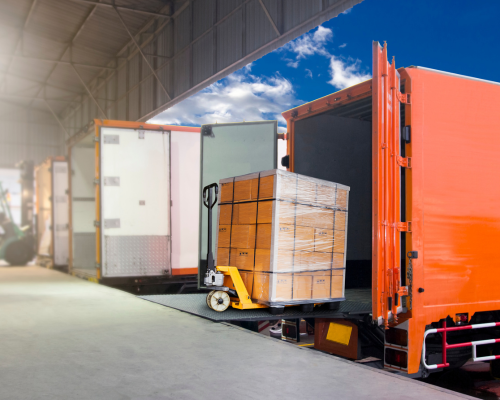10 min read
Ultimate Guide to Data-Riven Supply Chain Decision-Making
Supply chain managers make thousands of decisions every day, from inventory levels to shipping routes to warehouse staffing. However, too many of...
8 min read
Productiv : December 18, 2024

Your small business is picking up steam — more orders are coming in, customers are happy, and growth feels within reach. However, a problem is lurking behind all this success: your current warehouse setup is starting to crack under pressure.
20 Years of Kitting Excellence
Ready to Streamline Your Supply Chain?
Join industry leaders achieving 99%+ SLA performance with flexible kitting.
Fulfillment, and 3PL solutions. We handle over 100 million kits annually
Maybe you're running out of storage space faster than expected. Perhaps you're spending too much time manually tracking inventory or scrambling to find products when orders pile up. Or you're facing the classic small business dilemma — you need more warehouse capacity, but can't afford to commit to a massive long-term lease when you're not sure how big you'll be next year.
Luckily, flexible warehouse solutions are perfect for businesses like yours. Instead of forcing you into rigid, expensive setups, these solutions grow and adapt with your business. You get the space and systems you need right now, with the flexibility to scale as your business changes.
Let's explore how these solutions can transform your operations and fuel your growth!
One of the biggest strengths small businesses have over large corporations is agility. When market conditions shift or customer expectations change, they can adapt quickly. That flexibility is critical in modern warehousing, where the way you store, manage, and ship products can determine whether you stay competitive or fall behind.
Agility in warehousing means adjusting inventory levels without major delays, scaling storage as your business grows, and streamlining fulfillment to ensure customers receive their orders promptly. In an era of rising costs and unpredictable demand, this kind of responsiveness isn’t optional; it’s essential for survival.
Here's exactly why agility matters so much in modern warehousing:
When you move to flexible warehousing, you're not just getting more space – you're getting a whole new way of doing business that can transform how your company operates.
The best part of agile warehouse solutions is that they adapt to your business instead of forcing you into rigid constraints.
Do you need more space during your busy season? You can get it without signing a five-year lease. Are you hiring temporary staff for a product launch? The warehouse can accommodate extra workers without disrupting operations.
This flexibility means you're always right-sized for what's happening in your business at the moment, not what you thought might happen six months ago.
Traditional warehousing comes with hefty fixed costs that eat into your profits, whether you're busy or slow. Agile solutions flip this model by letting you share resources with other businesses and pay for what you actually use.
Rather than buying expensive warehouse management software, you get access to top-tier technology as part of the service. And instead of hiring and training your own warehouse staff, you tap into experienced teams that know how to handle operations efficiently.
The days of guessing what's in stock or discovering missing products during busy periods are far behind us.
Today, modern flexible warehousing gives you real-time visibility into every item in your inventory. You can see exactly what's moving fast, what's sitting too long, and what you need to reorder.
This level of insight helps prevent costly stockouts and reduces the money you have tied up in slow-moving inventory.
Speed matters more than ever, and agile warehouse solutions are built for it. Automated systems can pick, pack, and ship orders faster than manual processes, while optimized workflows ensure nothing gets stuck in bottlenecks.
This way, your customers will get their orders sooner, which means they're more likely to order again and recommend you to others.
When your warehouse operations run smoothly, your customer satisfaction grows.
Orders arrive on time and in perfect condition. Returns get processed quickly. Customers can track their packages and know exactly when to expect delivery.
All of this adds up to better experiences that turn one-time buyers into loyal customers who keep coming back.
The data flowing through modern warehouse systems is incredibly valuable for making smart business decisions. You can spot trends in customer behavior, identify your most profitable products, and predict when you'll need to restock.
This information helps you plan better, reduce waste, and find new growth opportunities that you might have missed otherwise.
Running a warehouse isn't easy when you're working with limited budgets and resources.
Most small businesses hit the same roadblocks as they try to scale their operations, and these challenges can seriously slow down growth if you don’t address them properly.
When you're starting, warehouse space is expensive and hard to predict.
You might lease too much space and waste money on empty square footage, or lease too little and quickly outgrow it. Finding the right location that's affordable but still gives you good access to customers and suppliers makes things even more complicated.
And then there's the equipment – forklifts, shelving, packing stations – all of which require upfront investment that can strain cash flow.
Many small businesses start with paper-based systems and manual picking processes because they seem cheaper initially.
However, as order volume grows, these manual methods become major bottlenecks. Workers spend time hunting for products, double-checking paperwork, and fixing errors that automated systems would prevent.
In the end, what worked when you had ten orders a day becomes a nightmare when you're handling 100.
Knowing exactly what you have in stock becomes incredibly challenging without proper systems.
You might think you have 50 units of a popular item, only to discover you're actually out when a big order comes in. And on the flip side, you might overstock slow-moving items that tie up your cash and take up valuable space.
Both scenarios hurt your bottom line and frustrate customers.
Getting the wrong product or the wrong quantity is one of the fastest ways to damage customer relationships.
Mistakes happen when you're relying on manual picking and packing – especially during busy periods when everyone's rushing to keep up.
After that, returns and exchanges eat into profits, and unhappy customers are unlikely to give you a second chance.
Holiday rushes and seasonal spikes can overwhelm small warehouse operations.
You might need three times your normal storage space and twice as many workers for just a few months out of the year.
However, hiring temporary staff is expensive and time-consuming, while maintaining excess capacity year-round doesn't make financial sense.
Modern warehouse management systems can cost tens of thousands of dollars, putting them out of reach for many small businesses.
And even if you can afford the software, you still need the hardware, training, and ongoing support to make it work effectively.
All this complexity can be overwhelming when you're already stretched thin managing other parts of your business.
The warehouse problems that slow down small businesses aren't unsolvable – they just require a different approach than what bigger companies use.
Smart small business owners are finding creative ways to get the warehouse capabilities they need without the massive overhead.
Shared warehousing lets you split costs with other businesses while still getting professional-grade facilities and equipment. You pay for only the space you use when you use it.
On-demand warehousing takes this even further – you can access warehouse space and services as needed without any long-term commitments.
These models give you the flexibility to scale up during busy periods and scale back when things slow down, all without the stress of managing your own facility.
You don't need a massive budget to benefit from automation.
Simple solutions like barcode scanners, automated sorting systems, and robotic picking assistants can dramatically improve accuracy and speed. Even basic conveyor systems can eliminate a lot of manual carrying and reduce picking errors.
The key is to start small with automation that solves your biggest pain points and expand as your business grows.
Cloud-based systems eliminate the huge upfront costs and technical complexity of traditional warehouse software.
You get real-time inventory tracking, automated reordering, and detailed analytics for a monthly subscription fee. Updates happen automatically, and you can access your data from anywhere.
This improves the playing field by giving small businesses access to the same powerful tools that big companies use.
Third-party logistics providers specialize in warehouse operations, which means they can handle your fulfillment more efficiently than you could on your own.
They already have the space, staff, systems, and shipping relationships in place. This means you’ll get professional warehouse management without the headaches of running it yourself.
Additionally, good 3PL partners can scale with your business, seamlessly handling seasonal spikes and growth spurts.
Planning for busy seasons makes all the difference.
Start by analyzing your sales patterns to predict when you'll need extra capacity and staffing. Make sure you work with flexible staffing agencies that specialize in warehouse workers, or partner with providers who can handle the seasonal surge for you.
Your goal is to have a plan in place well before you need it, so you're not scrambling when orders start pouring in.
Agile warehouse solutions are flexible systems that can quickly adapt to changing business needs without requiring major investments or long-term commitments. They're crucial for small businesses because they allow you to scale operations up or down based on demand while keeping costs manageable.
The key is to use shared resources and pay-as-you-go models instead of fixed overhead costs. This way, you only pay for the warehouse space, staff, and services you actually need, when you need them.
Technology automates manual processes, reduces errors, and provides real-time visibility into inventory and operations. Cloud-based systems make powerful warehouse management tools affordable for small businesses without huge upfront investments.
Yes, they're often ideal because they eliminate the risks and costs of managing your own facility while providing professional-grade operations. You get access to experienced staff, modern equipment, and scalable capacity without the overhead.
Better warehouse operations lead to faster, more accurate order fulfillment and reliable delivery times. When customers consistently receive their orders on time and in perfect condition, they're much more likely to become repeat buyers and recommend your business to others.
Small businesses need warehouse partners who understand their unique challenges and can grow with them. That's exactly what Productiv delivers: practical solutions that work for where your business is today and where it's headed tomorrow.
Productiv's warehouse model adapts to your business cycle rather than forcing you into rigid contracts. Whether you need extra space during peak seasons or want to scale back during slower periods, you get exactly what you need when you need it. No wasted space, no unused capacity – just smart warehousing that matches your business patterns.
Real-time inventory tracking means you always know what's in stock and where it's located. Productiv's systems automatically update as products move, so you can make informed decisions about restocking and avoid costly stockouts. Additionally, smart analytics help you spot trends and optimize your inventory levels based on actual sales data.
From the moment an order comes in to when it ships out, Productiv's fulfillment process is designed for speed and accuracy. Automated picking systems reduce errors, while optimized workflows ensure orders move through the warehouse efficiently. Your customers get their products faster, and you spend less time dealing with fulfillment issues.
Instead of paying for expensive warehouse management software and hiring specialized staff, you get access to professional-grade logistics services for a fraction of the cost. Productiv's shared resource model means you benefit from economies of scale while only paying for what you actually use.
As your business grows, Productiv grows with you. Whether you're adding new product lines, expanding into new markets, or handling seasonal surges, the infrastructure is already in place to support your growth. You won't hit warehouse capacity walls or struggle with operational bottlenecks as you scale up.

10 min read
Supply chain managers make thousands of decisions every day, from inventory levels to shipping routes to warehouse staffing. However, too many of...

11 min read
Running a growing business means managing more than just sales: it’s storage, shipping, and supply chain chaos. One delayed shipment or warehouse...

9 min read
Partnering with a 3PL (third-party logistics) sounds simple until you hit inventory transfers, integrations, and lost orders. Most businesses think...